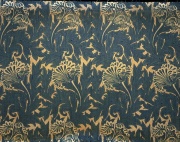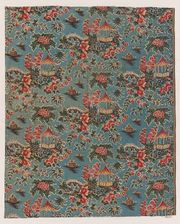Difference between revisions of "Chintz"
Jump to navigation
Jump to search
m (Text replace - "== Authority ==" to "== Sources Checked for Data in Record ==") |
|||
| (One intermediate revision by the same user not shown) | |||
| Line 1: | Line 1: | ||
| − | [[File:45.822b-SC741.jpg|thumb|]] | + | [[File:45.822b-SC741.jpg|thumb|'Tulip' pattern chintz<br>MFA# 45.822]] |
| + | [[File:Glazed chintz MFA48511.jpg|thumb|Glazed chintz<br>MFA# 48.511]] | ||
== Description == | == Description == | ||
| Line 8: | Line 9: | ||
cretonne; chintz (Esp., Ned), sits (Ned); | cretonne; chintz (Esp., Ned), sits (Ned); | ||
| − | == | + | == Resources and Citations == |
* Hoechst Celanese Corporation, ''Dictionary of Fiber & Textile Technology'' (older version called Man-made Fiber and Textile Dictionary, 1965), Hoechst Celanese Corporation, Charlotte NC, 1990 | * Hoechst Celanese Corporation, ''Dictionary of Fiber & Textile Technology'' (older version called Man-made Fiber and Textile Dictionary, 1965), Hoechst Celanese Corporation, Charlotte NC, 1990 | ||
Latest revision as of 08:17, 20 October 2020
Description
A printed and glazed fabric or paper with a brightly colored designed block printed in a repeating pattern. Chintz fabric has a plain weave and is typically made from Cotton or Linen. The glazed coating may be made from Wax, Starch, or Resin. Only the resin type glaze is washfast. Unglazed chintz fabrics are called cretonne. Chintz fabrics are used for draperies and upholstery.
Synonyms and Related Terms
cretonne; chintz (Esp., Ned), sits (Ned);
Resources and Citations
- Hoechst Celanese Corporation, Dictionary of Fiber & Textile Technology (older version called Man-made Fiber and Textile Dictionary, 1965), Hoechst Celanese Corporation, Charlotte NC, 1990
- E.J.LaBarre, Dictionary and Encyclopedia of Paper and Paper-making, Swets & Zeitlinger, Amsterdam, 1969
- Edward Reich, Carlton J. Siegler, Consumer Goods: How to Know and Use Them, American Book Company, New York City, 1937
- G.S.Brady, Materials Handbook, McGraw-Hill Book Co., New York, 1971 Comment: p. 456
- Art and Architecture Thesaurus Online, http://www.getty.edu/research/tools/vocabulary/aat/, J. Paul Getty Trust, Los Angeles, 2000

